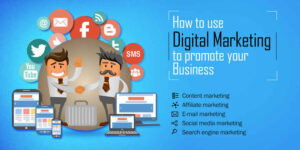Introduction
Marketing, at its core, is about reaching the right audience with the right message at the right time. For decades, traditional marketing — including television, radio, print, direct mail, and outdoor advertising — dominated this landscape. However, the digital revolution has significantly transformed how businesses interact with consumers. The rise of the internet, smartphones, and social media has given birth to digital media marketing — a more targeted, interactive, and data-driven approach.
The question now stands: Has digital media marketing finally overtaken conventional marketing? This essay aims to analyze both forms of marketing in terms of reach, cost-effectiveness, adaptability, measurement, consumer behavior, and trends. While digital marketing has certainly become dominant in many respects, the answer isn’t a simple “yes” or “no.”
It depends on industry, audience, and objective. Nevertheless, evidence increasingly points toward digital marketing taking the lead in today’s marketing ecosystem.
—
Traditional Marketing: A Brief Overview
Traditional marketing has been the cornerstone of advertising for over a century. It includes:
Print advertising: Newspapers, magazines, brochures, and flyers.
Broadcast advertising: Television and radio commercials.
Outdoor advertising: Billboards, transit ads, and posters.
Direct mail: Catalogs, postcards, and letters.
Telemarketing: Cold calls and phone promotions.
These methods were once unrivaled in reaching mass audiences. A television commercial during prime time could reach millions in a matter of minutes. Similarly, a full-page newspaper ad was considered premium space. Traditional marketing appeals strongly to demographics that are less digitally inclined and remains effective for local and regional businesses.
—
Rise of Digital Media Marketing
Digital media marketing refers to advertising delivered through digital channels such as search engines, websites, social media, email, and mobile apps. It includes:
Search Engine Optimization (SEO)
Pay-Per-Click (PPC) advertising
Social media marketing (Facebook, Instagram, LinkedIn, TikTok, etc.)
Email marketing
Content marketing
Affiliate marketing
Influencer marketing
The appeal of digital marketing lies in its ability to provide targeted, measurable, and often cost-effective campaigns. With billions of people using the internet and spending significant time on digital platforms, marketers have shifted budgets toward digital strategies.
—
Comparative Analysis: Digital vs. Conventional Marketing
1. Audience Reach and Engagement
Traditional marketing excels at reaching a broad demographic. A Super Bowl commercial, for instance, has the power to reach over 100 million viewers. However, digital marketing allows for highly targeted campaigns. Through analytics and algorithms, advertisers can segment audiences based on demographics, interests, browsing behavior, and location. Social media platforms like Facebook and Instagram provide tools for direct engagement — likes, comments, shares — fostering two-way communication.
Verdict: Digital marketing wins in engagement and precise targeting. Traditional marketing still dominates in broad reach, especially among older audiences.
2. Cost-Effectiveness
Traditional campaigns are expensive. A 30-second TV ad can cost thousands, not including production costs. Print ads, billboards, and radio spots also involve significant investment, often without guaranteed results.
In contrast, digital campaigns can start with minimal budgets. A \$5 Facebook ad can reach thousands with the right targeting. Moreover, cost-per-click (CPC) and performance-based models ensure marketers only pay for measurable outcomes, such as clicks or conversions.
Verdict: Digital marketing is more cost-effective and flexible, especially for small and medium-sized businesses.
3. Analytics and Measurability
One of digital marketing’s greatest strengths is measurability. Tools like Google Analytics, Facebook Insights, and email campaign trackers offer real-time feedback on performance — impressions, clicks, bounce rates, conversions, and more.
Traditional marketing struggles in this area. While Nielsen ratings can estimate TV viewership, there’s limited insight into direct impact. ROI from traditional methods often relies on correlation rather than concrete data.
Verdict: Digital marketing offers superior measurability and data-driven optimization.
4. Speed and Adaptability
Digital marketing campaigns can be launched within hours. If something isn’t working, it can be adjusted instantly — change the headline, target audience, or ad creative. Traditional marketing requires longer lead times for production, approval, and distribution. Adjusting a print ad or TV commercial mid-campaign is difficult and costly.
Verdict: Digital media marketing is more agile and responsive to change.
5. Consumer Behavior Trends
Consumer behavior has shifted dramatically in the digital age:
93% of online experiences begin with a search engine.
Over 4.8 billion people globally use social media.
Mobile devices account for more than 50% of internet traffic.
Users spend hours daily on platforms like YouTube, Instagram, and TikTok.
People research products, read reviews, and make purchases online. Younger generations (Millennials and Gen Z) especially prefer digital content over traditional media.
Verdict: The digital landscape aligns closely with evolving consumer habits.
—
Industries Where Traditional Marketing Still Thrives
While digital marketing is increasingly dominant, traditional methods remain relevant in several industries:
- Luxury Brands: High-end fashion and luxury goods often use glossy magazine spreads and TV ads to build prestige.
- 2. Real Estate: Print brochures and newspaper ads are still used, especially in local markets.
- 3. Automotive: TV commercials remain a staple for car companies.
- 4. Healthcare: Hospitals and clinics often rely on billboards, direct mail, and local radio.
- 5. Older Demographics: Traditional marketing is more effective with audiences who are not tech-savvy.
For these sectors, traditional marketing provides a tactile, trustworthy experience that digital platforms sometimes lack.
—
In conclusion, while digital media marketing now leads the way, the most successful brands will be those that integrate both traditional and digital approaches, leveraging each medium’s strengths to create a holistic and compelling customer experience.
Integration: The Rise of Omnichannel Marketing
Rather than seeing digital and conventional marketing as opposing forces, many successful brands blend both. This approach is known as omnichannel marketing — creating a unified experience across all customer touchpoints.
Example:
A consumer sees a TV commercial (traditional), googles the product (digital), visits the brand’s Instagram page (digital), and later receives a catalog in the mail (traditional).
This synergy amplifies brand visibility and strengthens the customer journey. Companies like Coca-Cola, Nike, and Apple employ omnichannel strategies to great effect, ensuring they’re visible wherever consumers are active.
—
Case Studies
1. Nike
Nike uses powerful traditional ads featuring athletes during major sports events, but also invests heavily in digital marketing. Its social media campaigns are interactive, visually compelling, and often go viral. Nike’s app and personalized email strategies further cement its digital presence.
- Dollar Shave Club
An example of a company built almost entirely on digital marketing. Their viral launch video combined humor and a compelling value proposition, and they leveraged YouTube, Facebook, and email marketing to grow their subscription model without traditional ads.
- The New York Times
Once primarily a print publication, The New York Times has transformed into a digital-first media company. Through SEO, paid subscriptions, and newsletters, it now earns most of its revenue from digital.
—
Challenges Facing Digital Media Marketing
Despite its dominance, digital marketing has challenges:
Ad Fatigue: Consumers are bombarded with ads and develop banner blindness.
Privacy Concerns: With increasing scrutiny around data usage (GDPR, CCPA), marketers face limitations on tracking and targeting.
Algorithm Dependence: Platforms change algorithms frequently, impacting reach.
Saturation: The low barrier to entry means competition is fierce.
These issues require digital marketers to constantly innovate and maintain ethical standards in their practices.
—
Future Outlook
The future of marketing is increasingly digital, but it won’t entirely eliminate traditional methods. Here’s what we can expect:
More AI and Automation: Chatbots, automated emails, and AI-generated content will streamline marketing.
Voice and Visual Search: SEO strategies will adapt to new search behaviors.
Influencer Marketing Growth: Social media influencers will continue to shape consumer choices.
Sustainability and Ethics: Brands will need to focus on values, not just visibility.
While digital marketing will dominate spending and strategy, traditional channels will still play a supporting role, especially in specific niches and integrated campaigns.
—
Conclusion
Digital media marketing has, by most measurable standards, overtaken conventional marketing in terms of influence, growth, and budget allocation. Its ability to offer precise targeting, instant feedback, scalability, and adaptability makes it a superior tool in the modern marketer’s arsenal.
However, this doesn’t mean traditional marketing is obsolete. It still holds power in certain contexts, especially where emotional storytelling, local presence, or high-impact visuals are needed. The most effective strategies often combine the best of both worlds.
In conclusion, while digital media marketing now leads the way, the most successful brands will be those that integrate both traditional and digital approaches, leveraging each medium’s strengths to create a holistic and compelling customer experience.










